
Gym workouts and Pilates may seem like two different worlds in the fitness industry, but combining the strengths of both can lead to a more gyrotonic training and balanced fitness regimen. While gym-goers typically focus on strength training, cardio, and functional exercises, Pilates offers a mindful approach to enhancing core strength, flexibility, and muscle endurance. For many fitness enthusiasts, integrating the two provides a complete workout that addresses both the larger muscle groups and the smaller stabilizing muscles. Whether you’re aiming for increased strength, improved posture, or injury prevention, the pairing of gym workouts and Pilates is a smart approach to achieving optimal fitness results.
At the gym, the focus is often on lifting heavier weights, pushing physical limits, and working towards muscle hypertrophy. Weight machines, free weights, and high-intensity interval training (HIIT) are popular methods that focus on improving muscular strength, cardiovascular health, and endurance. While these exercises are fantastic for building muscle mass and burning calories, they sometimes lack attention to the core muscles and mobility that support overall body function. This is where Pilates steps in to complement your routine by targeting the deep core muscles and enhancing stability, which can be neglected in typical gym settings.
Pilates, founded by Joseph Pilates in the early 20th century, is a low-impact exercise regimen designed to improve flexibility, strength, and alignment. At its core, Pilates is about controlled movements that enhance muscle activation, especially in the torso and pelvic region. The exercises emphasize precision and control rather than brute strength, making it an excellent companion to gym routines that focus more on raw power. Regular Pilates practice can help correct muscle imbalances and improve range of motion, which can reduce the risk of injuries often seen in gym-goers due to overtraining or improper technique.
For gym enthusiasts who engage in heavy lifting or endurance training, Pilates offers the benefit of improved posture and alignment, which can enhance performance. Poor posture, caused by muscle imbalances or improper form during workouts, can lead to chronic pain or injury. Pilates helps to counteract this by promoting better body awareness, alignment, and movement efficiency. The focus on controlled breathing and core engagement also transfers to gym workouts, allowing athletes to lift heavier and move more efficiently while minimizing strain on the body.
Pilates can also aid in recovery from strenuous gym sessions. Many gym-goers, particularly those focused on weightlifting or high-intensity training, experience muscle tightness and limited flexibility. Incorporating Pilates into a fitness routine helps stretch and lengthen muscles, increasing flexibility and reducing muscle soreness. The stretching exercises inherent in Pilates promote muscle recovery and help prevent stiffness, allowing athletes to return to their gym routines faster and with less discomfort.
Another advantage of combining gym workouts and Pilates is the mental clarity and focus Pilates promotes. While gym workouts can sometimes become monotonous or overly competitive, Pilates requires mental engagement, concentration, and focus. The meditative aspect of Pilates can improve mindfulness and reduce stress, which, in turn, enhances performance in the gym. Athletes who incorporate Pilates into their routines often report feeling more mentally refreshed and less prone to workout fatigue, as Pilates encourages a connection between mind and body.
For those new to fitness, blending gym workouts with Pilates offers an accessible path to overall well-being. The gym provides the foundation for building strength, while Pilates focuses on flexibility and core stabilization. Beginners can start with low-impact exercises on machines or light dumbbells, then introduce Pilates movements to enhance their flexibility and core strength. This balanced approach creates a well-rounded fitness program that caters to different aspects of physical health, preventing over-reliance on one style of exercise while fostering a sustainable, enjoyable fitness journey.
One of the significant benefits of Pilates is its adaptability to all fitness levels. Whether you’re an advanced athlete or a beginner, Pilates movements can be modified to suit your needs. This versatility makes it a valuable addition to any gym routine, as Pilates can target areas that traditional exercises might overlook. Advanced gym-goers can challenge themselves with reformer Pilates or more complex mat-based exercises, while beginners can stick to fundamental movements that improve mobility and core strength.
The fusion of gym training and Pilates can also be highly beneficial for athletes in sports that require a balance of power and agility, such as basketball, tennis, or martial arts. The strength and explosive power gained from gym workouts, when paired with the stability, balance, and flexibility fostered by Pilates, can improve overall athletic performance. This combination allows athletes to move with more grace and control, reducing the likelihood of injuries while improving their skill level in their respective sports.
In summary, gym workouts and Pilates offer complementary benefits that create a well-rounded fitness program. While the gym focuses on strength, endurance, and cardiovascular health, Pilates provides core stabilization, flexibility, and body alignment. By blending the two, fitness enthusiasts can achieve a more holistic approach to their training, improving overall strength, mobility, and injury prevention. Whether you are looking to enhance athletic performance, prevent injury, or simply maintain a balanced fitness routine, incorporating both gym workouts and Pilates can lead to better health and well-being.
Leave a Reply